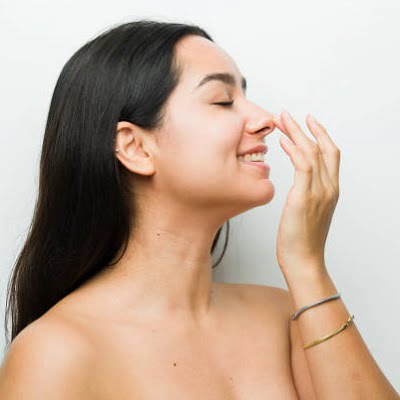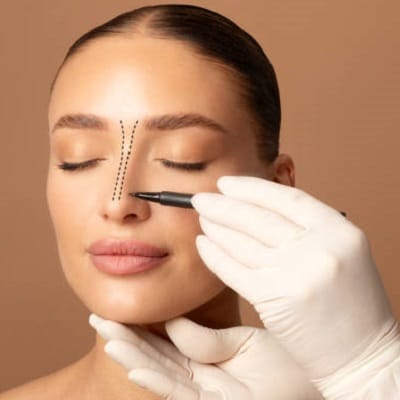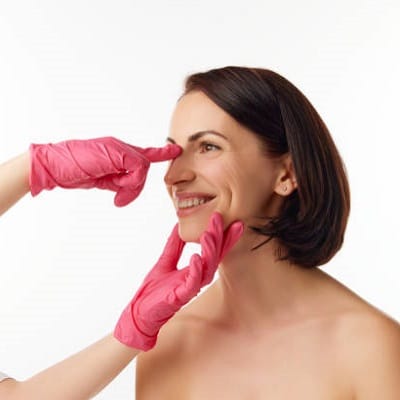
Rhinoplasty—a nose job is an example of this type of cosmetic operation. Many people are unaware that this surgery may have positive side effects. People also wonder if rhinoplasty improves breathing. This is why we’ll discuss rhinoplasty and its benefits on this page. Understanding these factors will help you decide if rhinoplasty is cosmetic or medicinal.
What is Rhinoplasty?
Rhinoplasty, or a nose operation, can help men and women improve their noses. A nose should do more than just look good. One of the main reasons patients consider this surgery is nasal dissatisfaction. Many people who seek rhinoplasty want to improve specific nose features, while others want to change their nose’s size or shape.
Benefits:
Rhinoplasty, which improves nose look and function, has many benefits:
- You can achieve facial harmony by building your nose to match your other features.
- Confronting concerns boosts self-esteem and fosters positive relationships.
- Functional changes are needed to address structural issues that cause respiratory and sleep issues.
- Customized, natural-looking results.
- Maintaining satisfaction requires long-term results.
- Self-confidence boosts personal and professional opportunities.
- Positive emotional adjustments usually improve mental and physical well-being.
Does Rhinoplasty Improve Breathing?
Nasal Valley Collapse:
The nasal airway narrows most at the nasal valve. It can collapse due to trauma, age, or surgery, disrupting nasal airflow.
Rhinoplasty Solution: Rhinoplasty stabilizes the airway, increasing breathing. This may strengthen or repair nasal valves.
Turbinate Hypertrophy:
Turbinate’s in the nose, humidify and cleanse air. They may block ventilation due to their bulk.
Rhinoplasty Solution: Rhinoplasty can increase airflow by shrinking the turbinate to make room in the nasal channel.
Nasal polyps:
Noncancerous growths that can block nasal airways can make breathing difficult.
Rhinoplasty solution: Rhinoplasty removes nasal polyps to open airways and improve breathing.
Trauma or injuries include:
Nasal injury may cause breathing problems.
Rhinoplasty solution: Trauma can be repaired via reconstructive rhinoplasty, restoring the nose’s look and function.
Aftercare:
- Instead of lying down on your face, lie up to reduce irritation.
- To avoid fainting during surgery or anesthesia, drink adequate water.
- Eat bland food soon after surgery.
- Avoid high-protein and high-fat foods.
- Consume bread, soup, milkshake, or carbohydrates.
- Do not touch your cast. Consult your surgeon immediately if it falls off or you have greasy skin.
- Avoid sun and moisture.
- Avoid hot, steamy showers. Lukewarm water.
- Shower the day you remove your cast. This prevents the cast from clinging to your skin, which is painful.
- Keep your nose wet with ointment instead of filling it.
- Disinfect blood with hydrogen peroxide. Try not to overclean.
- Avoid doing physical activity or going to Jim since sweating increases scar tissue and edema risk.
- Use salicylic acid toners after cast removal.
- Avoid salt and caffeine for two weeks following surgery.
Which candidate fits best?
Psychological and physical factors determine rhinoplasty suitability in Islamabad.
Considerations for the Body:
Rhinoplasty is usually done in late teens. Due to age and maturity requirements. Because the nose develops between 18 and 21, this happens.
Medicine and Medical History:
Good health is crucial. Your surgeon must know about your current drugs, allergies, and past diseases.
Particular Concerns for the Nasal Region:
Candidates undergoing functional rhinoplasty may have septal abnormalities that make breathing difficult. This surgery focuses on nasal function more than beauty.
The Rhinoplasty Operation:
If you want rhinoplasty to help breathe, you must comprehend the procedure.
Your surgeon will evaluate your nose, medical history, and breathing issues during the consultation. The doctor will create a customized surgery strategy based on your needs.
Have a board-certified surgeon with functional rhinoplasty experience do the surgery. Discuss risks including anesthesia reactions, bleeding, and infection with them.
After surgery, you may have pain, edema, and bruises. Most patients can return to work and mild exercise after one to two weeks. They should avoid intense activity for four to six weeks.
How long after rhinoplasty can I breathe normally?
Post-operational short-term complications include nasal stuffiness and mild swelling, which hamper normal breathing after rhinoplasty. Generally, breathing may become easier after 1-2 weeks as the swelling subsides. However, the complete rehab procedure may take several months, and its result is visible not earlier than up to one year.
Book a consultation:
In conclusion, rhinoplasty can enhance breathing by fixing structural abnormalities that block airflow. If you are considering this operation, visit with a knowledgeable surgeon to evaluate your needs and create a lifestyle-specific treatment plan.
Rhinoplasty assistance is best obtained from SKN Cosmetics experts. In addition to the aesthetic and functional benefits, you will breathe easier and feel better. Book a consultation!



